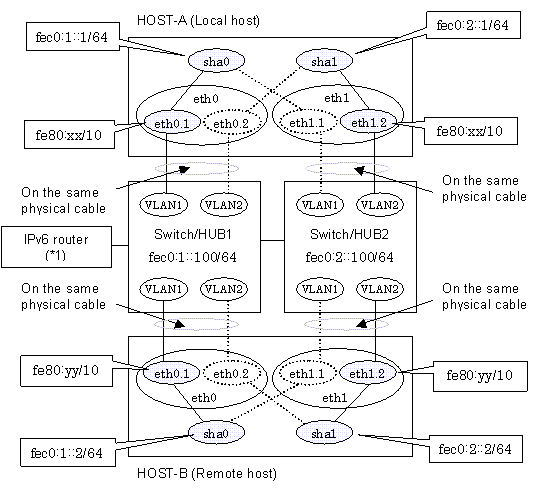

| PRIMECLUSTER Global Link Services Configuration and Administration Guide: Redundant Line Control Function 4.2 (for Linux) |
Contents
Index
 
|
| Appendix B Examples of configuring system environments | > B.5 Example of configuring NIC switching mode (IPv6) |
This section describes an example configuration procedure of the network shown in the diagram below.
The xx and yy in the figure below are assigned automatically by the automatic address configuration.
For the network configuration other than GLS, refer to "3.2.2 Network configuration".


An example of configuring /etc/radvd.conf to use Linux server as an IPv6 router is described below. For details on /etc/radvd.conf, refer to radvd.conf(5) manual. Do not configure radvd on the server running NIC switching mode.
1) On /etc/sysconfig/network-scripts/ifcfg-ethX or /etc/sysconfig/network/ifcfg-ethX file (ethX refers to an interface name), define a statement allows to activate the entire interfaces during the system startup. The following is an example of ifcfg-eth0.

In example (/etc/sysconfig/network-scripts/ifcfg-ethX) of setting the following, operating system is an example of RHEL4. Please refer to "3.2.2 Network configuration" for the setting examples other than RHEL4.
- Contents of /etc/sysconfig/network-scripts/ifcfg-eth0
|
DEVICE=eth0 |
2) When the system is RHEL, on /etc/sysconfig/network file, define a statement allows the system to load IPv6 module.
|
NETWORKING=yes |
3) Create /etc/radvd.conf file and define the following on the interface radvd uses. Depending on the versions of radvd, you must define the kernel parameter (net.ipv6.conf.all.forwarding=1) on /etc/sysctl.conf file. For details on this configuration, see radvd.conf(5) or radvd(8) manual.
interface eth0
{
AdvSendAdvert on; # Sending router advertisements
MinRtrAdvInterval 3;
MaxRtrAdvInterval 10;
prefix fec0:1::0/64 # Sending Prefix fec0:1::0/64 from eth0
{
AdvOnLink on;
AdvAutonomous on;
AdvRouterAddr on;
};
}; |
4) Reboot the system. Make sure radvd process is running after rebooting the system.
1-1) Define IP addresses and hostnames in /etc/hosts file.
fec0:1::1 v6hosta1 # HOST-A Virtual IP (1) fec0:2::1 v6hosta2 # HOST-A Virtual IP (2) fec0:1::2 v6hostb1 # HOST-B Virtual IP (1) fec0:2::2 v6hostb2 # HOST-B Virtual IP (2) fec0:1::100 swhub1 # Switch/HUB1 IP fec0:2::100 swhub2 # Switch/HUB2 IP |
1-2) Configure /etc/sysconfig/network-scripts/ifcfg-ethX (X is 0,1) file as follows.

In example (/etc/sysconfig/network-scripts/ifcfg-ethX) of setting the following, operating system is an example of RHEL4. Please refer to "3.2.2 Network configuration" for the setting examples other than RHEL4.
- Contents of /etc/sysconfig/network-scripts/ifcfg-eth0
|
DEVICE=eth0 |
- Contents of /etc/sysconfig/network-scripts/ifcfg-eth1
|
DEVICE=eth1 |
1-3) Configure /etc/sysconfig/network-scripts/ifcfg-ethX.Y (X is 0,1. Y is 1,2) file as follows.
- Contents of /etc/sysconfig/network-scripts/ifcfg-eth0.1
|
DEVICE=eth0.1 |
- Contents of /etc/sysconfig/network-scripts/ifcfg-eth0.2
|
DEVICE=eth0.2 |
- Contents of /etc/sysconfig/network-scripts/ifcfg-eth1.1
|
DEVICE=eth1.1 |
- Contents of /etc/sysconfig/network-scripts/ifcfg-eth1.2
|
DEVICE=eth1.2 |
1-4) When the system is RHEL, on /etc/sysconfig/network file, define a statement allows the system to load IPv6 module.
|
NETWORKING=yes |
Run the following command and reboot the system. After rebooting the system, verify eth0.1 and eth1.2 is enabled using ifconfig command.
/sbin/shutdown -r now
/opt/FJSVhanet/usr/sbin/hanetconfig create inet6 -n sha0 -m d -i fec0:1::1/64 -t eth0.1,eth1.1
/opt/FJSVhanet/usr/sbin/hanetconfig create inet6 -n sha1 -m d -i fec0:2::1/64 -t eth1.2,eth0.2
/opt/FJSVhanet/usr/sbin/hanetpoll create -n sha0 -p fec0:1::100 -b off
/opt/FJSVhanet/usr/sbin/hanetpoll create -n sha1 -p fec0:2::100 -b off
Please define only one Standby patrol monitoring function.
/opt/FJSVhanet/usr/sbin/hanetconfig create -n sha2 -m p -t sha0
Run the following command and reboot the system.
/sbin/shutdown -r now
1-1) Define IP addresses and hostnames in /etc/hosts file. Defined content is same as HOST-A.
1-2) Configure /etc/sysconfig/network-scripts/ifcfg-ethX (X is 0,1) file as follows.

In example (/etc/sysconfig/network-scripts/ifcfg-ethX) of setting the following, operating system is an example of RHEL4. Please refer to "3.2.2 Network configuration" for the setting examples other than RHEL4.
- Contents of /etc/sysconfig/network-scripts/ifcfg-eth0
|
DEVICE=eth0 |
- Contents of /etc/sysconfig/network-scripts/ifcfg-eth1
|
DEVICE=eth1 |
1-3) Configure /etc/sysconfig/network-scripts/ifcfg-ethX.Y (X is 0,1. Y is 1,2) file as follows.
- Contents of /etc/sysconfig/network-scripts/ifcfg-eth0.1
|
DEVICE=eth0.1 |
- Contents of /etc/sysconfig/network-scripts/ifcfg-eth0.2
|
DEVICE=eth0.2 |
- Contents of /etc/sysconfig/network-scripts/ifcfg-eth1.1
|
DEVICE=eth1.1 |
- Contents of /etc/sysconfig/network-scripts/ifcfg-eth1.2
|
DEVICE=eth1.2 |
1-4) When the system is RHEL, on /etc/sysconfig/network file, define a statement allows the system to load IPv6 module.
|
NETWORKING=yes |
Run the following command and reboot the system. After rebooting the system, verify eth0.1 and eth1.2 is enabled using ifconfig command.
/sbin/shutdown -r now
/opt/FJSVhanet/usr/sbin/hanetconfig create inet6 -n sha0 -m d -i fec0:1::2/64 -t eth0.1,eth1.1
/opt/FJSVhanet/usr/sbin/hanetconfig create inet6 -n sha1 -m d -i fec0:2::2/64 -t eth1.2,eth0.2
/opt/FJSVhanet/usr/sbin/hanetpoll create -n sha0 -p fec0:1::100 -b off
/opt/FJSVhanet/usr/sbin/hanetpoll create -n sha1 -p fec0:2::100 -b off
Please define only one Standby patrol monitoring function.
/opt/FJSVhanet/usr/sbin/hanetconfig create -n sha2 -m p -t sha0
Run the following command and reboot the system.
/sbin/shutdown -r now
Contents
Index
 
|